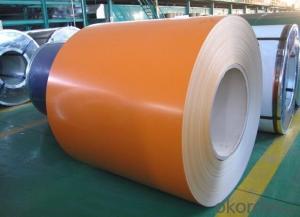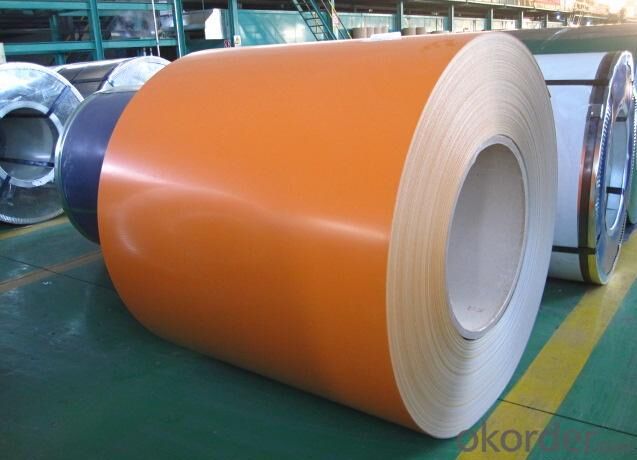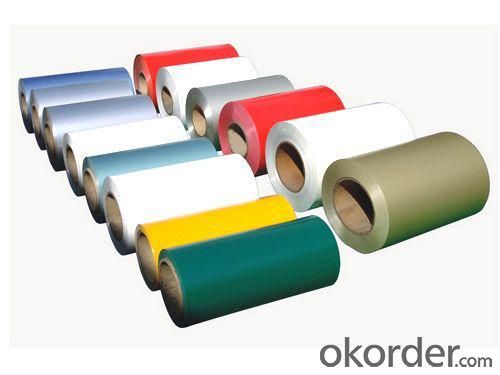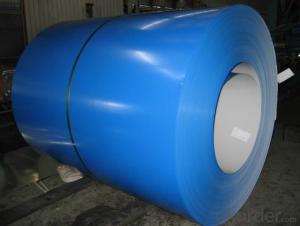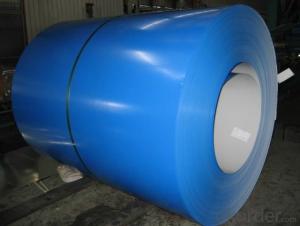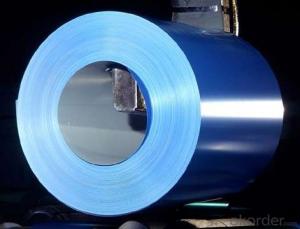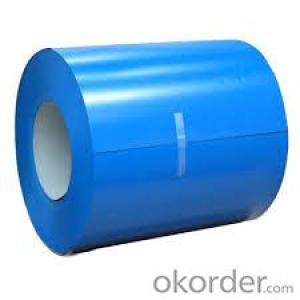Pre-Painted Galvanized Aluzinc Steel Coil High Quality
- Loading Port:
- China main port
- Payment Terms:
- TT OR LC
- Min Order Qty:
- 50 m.t.
- Supply Capability:
- 10000 m.t./month
OKorder Service Pledge
OKorder Financial Service
You Might Also Like
Specification
Pre-Painted Galvanized/Aluzinc Steel Coil from China in High Quality
Description
With GI as base material, after pretreatment (degrease and chemical treatment ) and liquid dope with several layers of color, then after firing and cooling, finally the plate steel is called pre-painted galvanized (aluzinc) steel.
Main Features
• Workability, durability
• Excellent heat resistance performance
• High strength
• Good formability
• Good visual effect
Specification
Standard: AISI, ASTM, BS, DIN, GB, JIS
Technique: Cold Rolled
Surface Treatment: Coated
Application: Boiler Plate
Special Use: High-strength Steel Plate
Width: 20-1250mm
Length: customized
commoidty: pre-painted galvanized steel coil
Thickness: 0.13-4.0mm
width: 20-1250mm
zinc coating: 40-180g/m2
printing thickness: top side: 20+/-5 microns, back side: 5-7 microns
color: all RAL color
surface treatment: color coated
coil weight: 4-7 tons
coil ID: 508/610mm
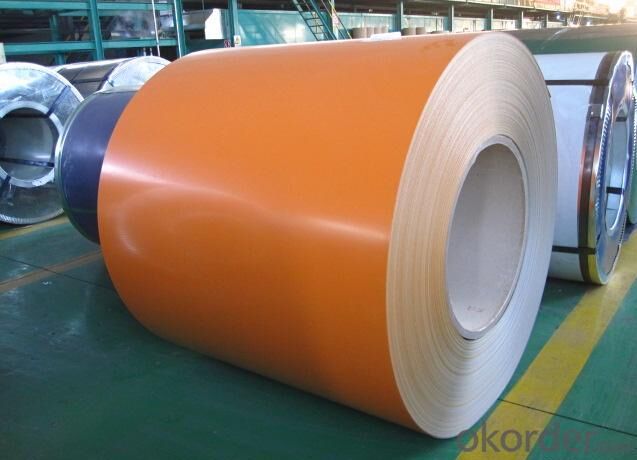
- Q: Why does steel with several composites have a greater hardenability from quenching than low carbon steel alloys?Any help would be great
- Bit tricky to explain and I don't know muh about it but steel on its own has lost of gaps in it ( the molecular structure) and when carbon is added thos gaps are filled, I think of it like this: it is easier to punch through expanded polystyrene( with all the little balls) than unexpanded(just a lump of plastic) as the balls are not properly joined and have air pockets between them.
- Q: What are the different methods of recoiling steel coils?
- Depending on the specific requirements and characteristics of the material, there are several methods employed for recoiling steel coils. Some commonly used techniques include: 1. Slitting: This method entails cutting the steel coil into narrower strips, which can then be recoiled. Rotary knives or circular saws are typically utilized in the slitting process, allowing for precise control over the width. 2. Rewinding: This approach involves unwinding the steel coil and subsequently rewinding it onto a new coil mandrel. It is commonly employed when resizing the original coil is necessary or when reconditioning a damaged coil. 3. Recoiling with a tension control system: This method passes the steel coil through a series of tension control rollers that apply a controlled amount of tension to the material. Consequently, the recoiling process is smooth and even, minimizing the risk of coil distortion or damage. 4. Recoiling with a slitter head: Combining the slitting and recoiling processes, this method employs a slitter head to simultaneously cut the steel coil into narrower strips and rewind them onto separate coils. 5. Recoiling with a looping pit: This technique involves feeding the steel coil through a looping pit, allowing for the accumulation of material as the coil is recoiled. This helps maintain a consistent line speed and tension throughout the recoiling process. Each of these methods possesses distinct advantages and is suitable for various applications. The choice of recoiling method depends on factors such as desired coil dimensions, material thickness and strength, and the required level of precision and quality.
- Q: How are steel coils used in the production of bridges and infrastructure?
- Steel coils are indispensable in the manufacturing of bridges and infrastructure. Made from sturdy and long-lasting steel, these coils can endure heavy loads and harsh environmental conditions. When constructing bridges, steel coils are utilized to produce structural elements like beams, girders, and columns. These components offer the necessary strength and support to the bridge, enabling it to bear the weight of vehicles, pedestrians, and other loads. The steel coils are shaped through rolling, cut to the required length, and then welded or bolted together to form these structural elements. Moreover, steel coils are also employed in the creation of bridge decks, which serve as the roadways or walkways on the bridge. These coils are processed into steel plates, which are then assembled and secured onto the bridge structure. The steel plates provide a smooth and durable surface for vehicles and pedestrians to traverse. Regarding infrastructure, steel coils play a crucial role in the construction of various structures such as buildings, stadiums, and industrial facilities. They are utilized to fabricate primary support systems, including columns, beams, and trusses, which furnish the necessary strength and stability to these structures. Steel coils are also used to manufacture roofing and cladding systems, ensuring protection against weather elements and enhancing the overall aesthetics of the infrastructure. Furthermore, steel coils frequently contribute to the production of reinforcing bars, commonly known as rebar. Rebar is essential for strengthening concrete structures like foundations, walls, and slabs. These coils are processed into different sizes and shapes, and subsequently embedded within the concrete to enhance its tensile strength and prevent cracking or collapsing under heavy loads. In conclusion, steel coils are a vital component in the manufacturing of bridges and infrastructure. Their strength, durability, and versatility make them an ideal material for constructing secure and dependable structures that can withstand the test of time.
- Q: How much do steel coils weigh?
- The weight of steel coils can vary depending on several factors such as the thickness, width, and length of the coil, as well as the specific type of steel being used. Generally, steel coils can weigh anywhere from a few hundred pounds to several tons. It is important to note that steel coils are typically measured in terms of their weight per unit area, known as the coil's "basis weight" or "coil weight".
- Q: How do steel coils contribute to the automotive manufacturing sector?
- Steel coils are essential in the automotive manufacturing sector as they are used to produce various components such as body parts, frames, and suspension systems. The high strength and durability of steel coils make them ideal for ensuring the safety and structural integrity of vehicles. Additionally, steel coils are easily moldable, allowing manufacturers to create complex shapes and designs, contributing to the overall aesthetics and functionality of automobiles.
- Q: What are the different methods of coil leveling?
- The different methods of coil leveling include roller leveling, stretcher leveling, and temper leveling.
- Q: hi, i have a steel block with an unussual composition. does anyone know if this is any particular type?c- .6%, si - .33%, mn - .6%, sulphur - .014%, phosphorous - .013%, ni - 1.69%, Cr, 1.07%, molybdenum - .67%
- You have opened a can of worms. Specific types of steel vary not only by composition but by the way they were made, their physical properties and their morphology (microscopic structure). The composition you have given would fit for High Carbon Steel and Medium Carbon Steel. Go to the reference I've given, it allows you to put in 3 of the components of your alloy and then it gives you a list of possibilities. You can open each candidate individually and see the full composition. Hours of fun. :)
- Q: How are steel coils inspected for flatness?
- To ensure they meet the necessary standards, steel coils undergo a variety of methods and techniques to inspect their flatness. Trained inspectors visually examine the coil's surface for signs of waviness or unevenness, searching for visible defects like waves, buckles, or twists that could impact its flatness. Another approach involves using specialized equipment such as flatness gauges or profilometers to inspect the coil's flatness. These instruments measure the surface profile and provide detailed information about any deviations from the desired flatness. They can detect both local and overall flatness issues, offering a more precise assessment of the coil's quality. In addition to visual and instrumental inspections, physical tests can also be conducted to evaluate the flatness of steel coils. The "drape" test, for instance, involves draping the coil over a flat surface and measuring any noticeable gaps or unevenness. This test quickly identifies major flatness problems. Moreover, computerized analysis and simulation techniques are gaining popularity for inspecting the flatness of steel coils. These methods utilize advanced software to analyze the coil's surface data and generate comprehensive reports on its flatness characteristics. By comparing the actual surface profile with the desired specifications, these techniques provide a thorough assessment of the coil's flatness. Overall, the inspection of steel coils for flatness combines visual inspection, specialized equipment, physical tests, and advanced analysis techniques. These methods ensure that the coils meet the necessary flatness standards, which is essential for their successful application in industries such as automotive, construction, and manufacturing.
- Q: What are the different cutting methods for steel coils?
- Steel coils can be cut using various methods depending on specific requirements and desired outcomes. Some commonly used cutting methods for steel coils include: 1. Slitting: Narrower strips can be obtained by cutting the steel coil using a slitting machine equipped with multiple circular blades. The coil is unwound and passed through the blades, resulting in the desired width. Slitting is commonly employed in industries like automotive manufacturing or electrical appliance production, where narrower steel strips are needed. 2. Shearing: This method involves using a shear machine with a straight blade to cut through the steel coil. The blade presses against the coil, cutting it into desired lengths or shapes. Shearing is ideal for applications requiring precise cuts or specific sizes. 3. Laser cutting: A high-powered laser is used to cut through the steel coil in this advanced method. The laser beam is directed onto the coil, melting or vaporizing the metal to create a clean and accurate cut. Laser cutting is highly precise and can be used to cut intricate designs or patterns into the steel coil. It finds applications in industries such as aerospace, automotive, and electronics. 4. Plasma cutting: A high-velocity jet of ionized gas, usually a mixture of oxygen and an inert gas like nitrogen or argon, is employed to melt and remove metal from the steel coil. Plasma cutting is known for its speed and versatility, as it can cut through various metals, including steel. It is commonly used in industries like shipbuilding or construction, where fast and efficient cutting is required. These are just a few of the cutting methods available for steel coils. The choice of method depends on factors such as desired outcome, coil thickness, and specific application requirements. It is advisable to consult with a professional or specialist to determine the most suitable cutting method for your specific needs.
- Q: A steel rod AISI 1040 has the ultimate tensile strength Sut of 113 kpsi. Determine the rotating bending specimen's endurance limit S'e at 10 to the 6th cycles.
- It okorder
Send your message to us
Pre-Painted Galvanized Aluzinc Steel Coil High Quality
- Loading Port:
- China main port
- Payment Terms:
- TT OR LC
- Min Order Qty:
- 50 m.t.
- Supply Capability:
- 10000 m.t./month
OKorder Service Pledge
OKorder Financial Service
Similar products
Hot products
Hot Searches
Related keywords
